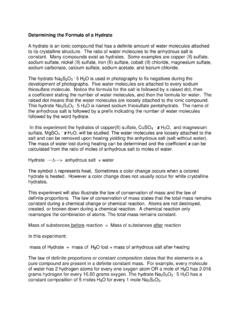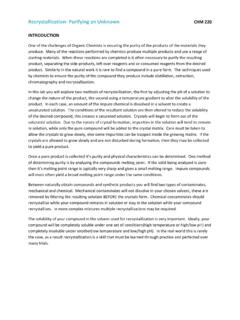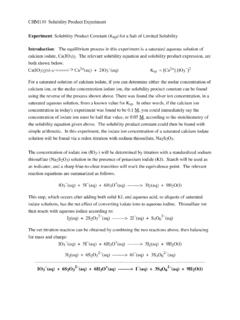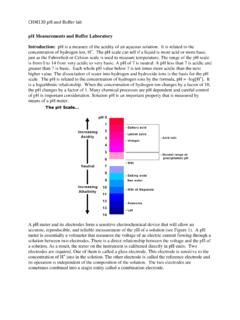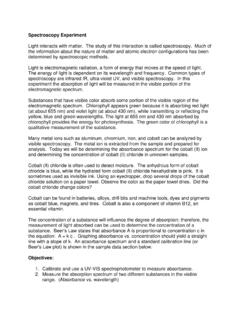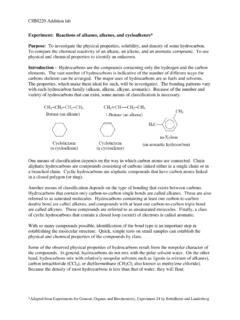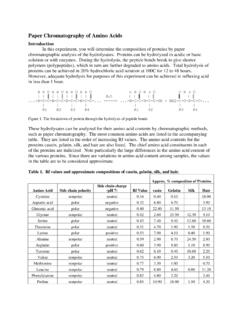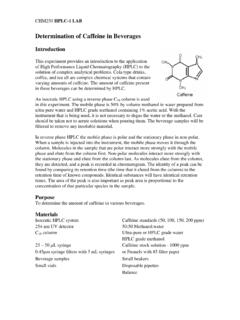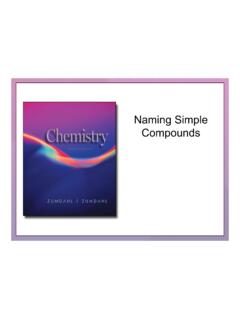Transcription of Experiment: Identification of Unknowns* Introduction
1 CHM230 Identification of Unknowns Lab *Adapted from Introduction to Organic Laboratory Techniques by Pavia, Lampman, and Kriz 3rd edition and Organic Chemistry Laboratory Standard and Microscale Experiments by Rodig, Bell, and Clark. Experiment: Identification of Unknowns* Introduction : Along with synthesis and the examination of the reaction mechanisms, an equally important part of organic chemistry has to do with the characterization and Identification of compounds, which may be encountered in sources ranging from a laboratory reaction to exotic tropical plants.
2 In any case, sufficient information must be accumulated to establish the identity of the compound in question with that of a previously described compound of known structure or else to determine from the beginning the structure of the unknown. Qualitative organic analysis is an important part of organic chemistry. Every chemist must learn the appropriate methods for establishing the identity of a compound . Although it is often possible to establish the structure of a compound on the basis of spectra alone (IR, NMR, MS, etc.)
3 , the spectra typically must be supplemented with other information about the compound : physical state and properties (melting point, boiling point, solubility, odor, color, etc.), elemental analysis, and confirmatory tests for functional groups. In this experiment you will be issued an unknown compound and asked to identify it through chemical and spectroscopic methods. You must first determine the class of compound to which the unknown belongs, that is, identify its main functional group; and then you must determine the specific compound in that class that corresponds to the unknown.
4 The unknowns provided in this experiment are of the purity normally encountered in commercial organic chemicals, which are usually in the range of 95 to 99%. Minor impurities will generally not interfere in the Identification procedure. If problems are encountered, recrystallization or distillation of a sample of the unknown may be desirable. General instructions: Part One 1. Preliminary classification by physical state, color, and odor 2. Melting-point or Boiling-point determination; other physical data 3. Determination of solubility behavior in water and in acids and bases 4.
5 Simple preliminary tests: beilstein, ignition (combustion) 5. Application of relevant chemical classification tests Part Two 6. Determination of IR and NMR spectra Each of the above steps is discussed in detail in Appendix A. Record all data using excel, word, or notebook paper. All data will be turned in with the laboratory experiment (ALL six parts). A combined report for your lab group will be submitted summarizing your data and the final identity of your unknown compound . Make sure you include the unknown Identification on your report along with the compound name for your unknown ( Unknown A is m-nitrotoluene).
6 2 | P a g e Appendix A. READ all instructions thoroughly BEFORE you conduct any experiment. 1. Preliminary Classification Your group should note the physical characteristics of the unknown. These include its color, its odor, and its physical state (liquid, solid, crystalline form). Many compounds have characteristic colors or odors, or they crystallize with a specific crystal structure. This information can often be found in a handbook and can be checked later. Compounds with a high degree of conjugation are frequently yellow to red.
7 Amines often have a fishlike odor. Esters have a pleasant fruity or floral odor. Acids have a sharp and pungent odor. As a note of caution, many compounds have distinctly unpleasant or nauseating odors. Some have corrosive vapors. Any unknown substance should be sniffed with the greatest caution. As a first step, open the container, hold it away from you, and using your hand, carefully waft the vapors toward your nose. If you get past this stage, a closer inspection will be possible. 2. Melting-Point or Boiling-Point Determination The single most useful piece of information to have for an unknown compound is its melting point or boiling point.
8 Either piece of data will drastically limit the compounds that are possible. Melting-point: to save time, you can often determine two separate melting points. The fist determination can be made rapidly to get an approximate value. Then, after the instrument has cooled off, you can determine the second melting point more carefully. Boiling-point: is easily obtained by a simple distillation of the unknown. The simple distillation has the advantage that it also purifies the compound . The smallest distilling flask available should be used if a simple distillation is performed, and you should be sure that the thermometer bulb is fully immersed in the vapor of the distilling liquid.
9 For an accurate boiling-point value, the liquid should be distilled rapidly. 3. Solubility Behavior Solubility tests should be performed on every unknown. The solubility of an organic compound in water, dilute acid, or dilute base can provide useful information about the presence or absence of certain functional groups. The tests are very simple and require only small amounts of the unknown. In addition, solubility tests reveal whether the compound is a strong base (amine), a weak acid (phenol), a strong acid (carboxylic acid), or a neutral substance (aldehyde, ketone, alcohol, ester).
10 The common solvents used to determine solubility types are: water, HCl, concentrated H2SO4, NaHCO3, NaOH, and organic solvents. A flowchart showing the sequence of solubility tests along with the appropriate conclusions is shown in Figure 1. Further information about each of the solubility tests follows the procedure. Procedure. Place about 1mL of the solvent in a small test tube. Add one drop of an unknown liquid from an eyedropper, or a few crystals of an unknown solid from the end of a spatula, directly into the solvent.
